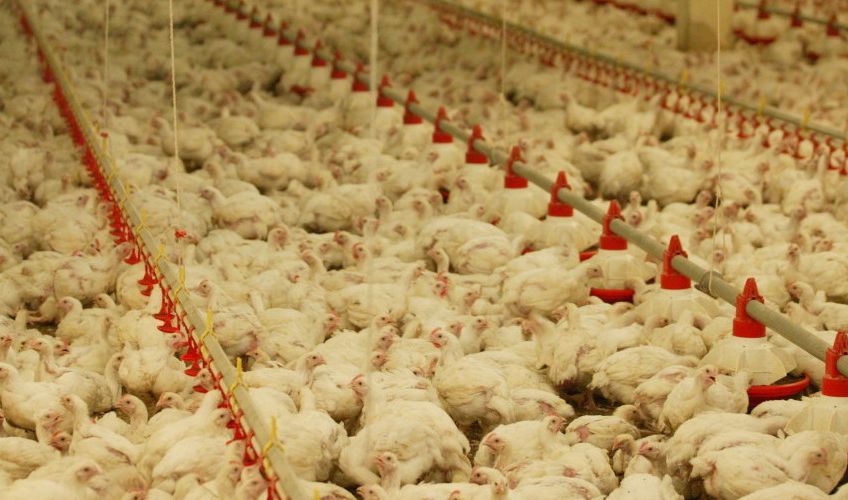Eleni Mitsou is a member of Xekinima (ISA in Greece).
The Destruction of Nature and Intensive Farming Leads to Pandemics
The pandemic of COVID-19, caused by the new coronavirus (SARS-Cov-2), didn’t take everyone by surprise. For more than a decade, dozens of scientists around the world have been warning of the outbreak of pandemics, due to “super-viruses” from animals and microbes resistant to antibiotics, and have called on governments to take action.
The warnings have not come from “fringe” voices or even just individual scientists. There have been forecasts of such pandemics in the UN Food and Agriculture Organization (FAO) studies Changing disease landscapes and Industrial livestock production and Global health risks, and the risks have even been acknowledged, relatively recently, by even the US Secret Service.
Dr. Robert Webster is one of the scientists who have been warning for decades about the outbreak of pandemics by so called “zoonotic diseases,” that is diseases that involve the transmission of viruses from animals to humans. Dr. Webster heads the World Health Organization (WHO) laboratory on lower animal and bird influenza, specializing in the interface between humans and animals. He has been warning of a deadly pandemic for almost 60 years. One of the types of flu virus that has been a major concern for him for the past 20 years is H5N1, which kills 50% of humans it infects. What “limits” H5N1 so far is that it is very difficult to transmit from human to human – in contrast to the high degree of contagion of the coronavirus that causes COVID-19.
Despite the warnings, governments around the world had not taken any substantial steps to reduce the incidence of such viruses, nor to prepare for pandemics.
Taking such action would inevitably bring them into conflict with the big business interests that destroy forest ecosystems including the industrial agriculture, logging and mining multinationals, as well as the intensive animal farming industry. Secondly, governments would have to invest in research on the treatment of viruses, as well as equip and “shield” public health systems – policies that cost a lot of money and bring no returns or high profits to big capital.
The destruction of forests leads to an increase in human diseases
Diseases transmitted from animals to humans are not new. It is a phenomenon almost as old as agriculture and farming practices.
Jared Diamond, the author of “Guns, Germs and Steel,” which is now considered by many to be a classic, wrote about a decade ago: “The major killers of humanity throughout our recent history – smallpox, flu, tuberculosis, malaria, plague, measles, and cholera – are infectious diseases that evolved from diseases of animals[…] Until World War II, more victims of war died of war-borne microbes than of battle wounds.”
Indeed, measles came from cattle, smallpox is thought to have been transmitted to humans by camels, influenza (the flu virus) by chickens and pigs, and so on. However, in the second half of the 19th century, many infectious diseases had been controlled through vaccinations and other means.
Yet, the capitalist model of development had already paved the way for the spreading of new viruses or new virus-strains and for the outbreak of new pandemics.
In the 1980s, large logging companies started cutting down forests in Central and West Africa. One of the consequences of logging on a massive scale was the building of roads which allowed hunters to penetrate deeper into the forests and gain access to more prey. In addition, the use of rifles, which accompanied the colonisation of the African continent, made hunting much more efficient. Workers at logging companies, mines and oil fields operating in cleared forest areas, began consuming bush-meat more often. The newly constructed roads and the operation of large trucks also enabled the transferring of more prey into the cities. Thus the destruction of huge parts of African tropical forests was accompanied by a steep rise in bush-meat trade, including meat from chimpanzees and gorillas, which brought viruses from those animals into a much more frequent contact with a much greater number of people, compared to the past. One of these viruses was the deadly Ebola haemorrhagic fever. It was through similar processes, accompanied by significant social change in Congo, including urbanization and an increase in prostitution, imposed by the Belgian colonialist rule, that the AIDS virus began to spread towards the end of the 19th century – a virus that, again, passed to humans through chimpanzees.
“How forest loss is leading to a rise in human disease” is the title of an article in the online journal of Yale University’s School of Forest and Environmental Sciences. The article describes how replacing forests with huge plantations for producing palm oil, the most marketable type of oil globally, or with grain and crop plantations for livestock feed leads to large outbreaks of infectious diseases such as malaria and dengue fever.
One of the mechanisms of transmission has been identified in Borneo. Scientists studying the increase in malaria cases within the communities that surrounded the jungle “realized the primates were concentrating in the remaining fragments of forest habitat, possibly increasing disease transmission among their own populations. Then, as humans worked on the new palm plantations, near the recently created forest edges, mosquitoes that thrived in this new habitat carried the disease from macaques to people.”
Similarly, a 2010 study in Brazil found that for every 4% in forest devastation, the incidence of malaria in humans increased by 50%. As for the destruction of Uganda’s forests, it has caused, among other things, the transmission, again through mosquitoes, of the Zika virus to the Americas and Asia. The Zika virus causes microcephaly, underdevelopment of the brain, and other serious complications in fetuses.
It’s not just primates and mosquitoes that can transmit diseases to humans. Bats, rodents and even snails are carriers of dangerous viruses. The destruction of animal habitats, the change in the dynamics in their populations as well as the change in the dynamics and the balance between human and animal populations, lead to the transmission of new viruses or new virus strains from animals to humans that can develop into epidemics and pandemics.
From the capitalist industrial breeding to COVID-19
Intensive agriculture and especially intensive animal farming, which aim at maximizing capitalist profits, are the two main causes of deforestation, followed by mining and industrial logging. They lead to the transmission of zoonotic diseases to humans both directly and indirectly.
In the early 1990s, China began to industrialize food production based on the capitalist model. One of the consequences was that small and medium-sized farmers could no longer compete with huge intensive animal farms. In order to survive, small farmers turned to raising wild animals which until then were rarely consumed and mainly only for subsistence. Consumption of wild animal meat gradually became part of the food market and the formal economy and has led to greater human contact with the viruses, bacteria and parasites of this “new livestock.”
Wildlife breeding farms have been set up at forest edges where the “wild livestock” come into contact with other wild animals such as bats, probably in a different type of contact than the one they might have in the wild, and with their viruses. It is in this way that SARS-CoV was transmitted from bats to civet cats and through them to humans. SARS-CoV2, which causes the COVID-19 disease, is believed to have been transmitted to humans by bats through pangolins.
Capitalist intensive animal farming – ideal for the incubation of super-viruses
According to Rob Wallace, an evolutionary biologist at the Agroecology and Rural Economics Research Institute in St. Paul, Minnesota “factory farms are the best way to select for the most dangerous pathogens possible.” [note pathogens are viruses, bacteria, fungi and parasites]
The reality of factory farming, the most common type of intensive animal farming, is nothing like commercial advertisements picturing cows grazing in the meadows and chickens strolling in big barns. The real picture is one of huge factories with tens and hundreds of thousands of animals, immobilized with metal bars or in cages, standing for much of the day in their feces, away from the sun. The sun’s ultraviolet radiation kills viruses, among other things. These conditions dramatically increase the stress on the animals and severely weaken their immune system.
The huge concentration in numbers of these animal populations, and on top of their immobility with compromised hygiene, creates conditions similar to those in the trenches and barracks of soldiers in World War I, where the deadliest flu pandemic in modern history broke out, the “Spanish flu.”
In addition, the animals in industrial breeding are virtually genetically identical, as the breeds are created by selecting specific genes in order to have the desired characteristics – large breast in the case of chickens, production of large amounts of milk in the case of cows and so on. However, this means that a virus or other pathogens can easily spread from animal to animal without encountering genetic variations that could obstruct its path.
The “swine flu” in 2009, which killed about 18,500 people, was a new strain of the H1N1 flu. It emerged in the industrial pig farms of North America and from there spread to humans.
Antibiotics
The conditions in which animals live in the intensive animal farming industry often lead to the emergence and spread of disease. In order to prevent situations that would reduce their profits and also to promote the growth of the animals, the industry administers antibiotics to the livestock pre-emptively, often as part of their feeds.
Scientists warn that these practices lead to the development of microbes resistant to all known antibiotics. Already in Europe, 23,000 people die each year from antibiotic-resistant bacteria, while in the United States that number is estimated at 25,000. By 2050, some scientists estimate, these deaths will reach 10 million a year worldwide, exceeding the number of cancer deaths.
The food industry is putting people and nature at risk
The food industry claims that intensive agriculture and intensive animal farming is “necessary” to produce enough food for everyone. But almost 50% of the food produced in the world is discarded before it is consumed.
At the same time, a quarter of the world’s population lives in conditions of food insecurity – they do not have enough food either permanently or periodically
Intensive agriculture and farming do not aim to feed the world’s poor, but to increase the wealth and profits of the food and pharma industry’s conglomerates.
While industrializing meat production, the food multinationals have also promoted a culture of excessive meat consumption in the western world, where people eat meat up to 3 times a day instead of just a few times a week that previous generations would eat. Overconsumption of meat, however, is shown to be detrimental to human health, while intensive animal farming drains huge amounts of natural resources.
In order to make use of resources such as water, grains for livestock feed, etc., forests, mainly tropical, and other ecosystems are being destroyed. At the same time, intensive animal farming and agriculture indirectly and directly expose people to dangerous pathogens.
When Dr. Webster was asked in a recent TV interview, if COVID-19 was the pandemic he has been predicting, he replied: “the short answer is no” and explained than in the future we will face much more lethal viruses.
We demand
- An immediate end to the destruction of forests and the remaining ecosystems .
- Radical change in the modern capitalist agricultural and farming model. Replace intensive agriculture with ecologically sustainable agriculture and the use of traditional seed varieties which have been adapted over centuries to the particular environment of each region. Replace intensive animal farming with sustainable extensive livestock farms with the traditional animal breeds for each region.
- Mass education campaigns about the dangers of over-consumption of meat on the environment and our health and a shift from the dietary model promoted in the west and the industrial world which includes apart from unsustainable quantities of meat, processed and low quality products on a large scale.
- The establishment of democratically-run agricultural and livestock cooperatives under conditions of full transparency to produce high-quality, affordable food and at the same time provide a living wage for all workers in agriculture and farming.
- Scientific and material support to the cooperatives and small/medium farms from the state. For an agricultural and animal farm production plan based on the real needs of society and not of the profits of the multinationals.
- Mass public sector investment into research to fight viruses. Scientific research should be conducted from public research centres, universities and other institutions in the interest of society. The research findings and all new treatments, drugs, etc should be the property of society and not of private companies that use them for profit.
- Expansion and mass investment in the public health care systems: mass hiring of staff, construction of new hospital units, adequate supplies of necessary equipment, creation of large stockpiles to be used in future epidemic/pandemic emergencies
These radical changes, both in the way food is produced and in the approach of the public sector and public health, are incompatible with a system that operates on the basis of the profit for multinationals, capitalist market competition and the ecological disaster it calls “development” and “growth.” Protecting public health, avoiding new – possibly even more deadly – pandemics and protecting the environment, are linked directly to the struggle to overthrow capitalism and build a democratic socialist society. A society where the main means of production will be publicly owned and under the democratic control and management of society, with real equality, democracy, transparency and freedom. A new society which can protect the environment and put an end to the exploitation, poverty and hunger that characterize capitalism from its inception.




